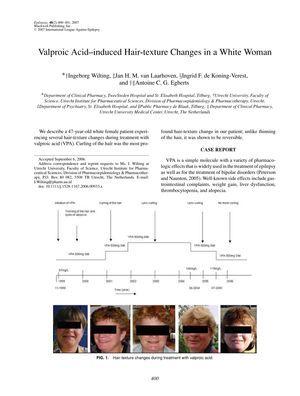Valproic Acid-Induced Hair-Texture Changes in a White Woman
January 2007
in “
Epilepsia
”

TLDR Valproic acid can cause reversible hair curling and persistent hair thinning.
In 2007, a case was reported of a 47-year-old white female patient who experienced changes in hair texture, specifically curling, during treatment with valproic acid (VPA), a medication commonly used for epilepsy and bipolar disorders. The curling effect was reversible, unlike the thinning of her hair which persisted. The prevalence of VPA-induced hair-texture changes was previously reported to be 11% in a study of 284 patients and 2% in another study of 250 patients, with effects typically appearing after 3 to 6 months of treatment. The mechanism behind VPA's impact on hair is not fully understood, but may involve chelating of metals or inhibition of metallic enzymes important for hair growth and keratinization. Physicians are advised to inform patients about the potential effects of VPA on hair texture.




